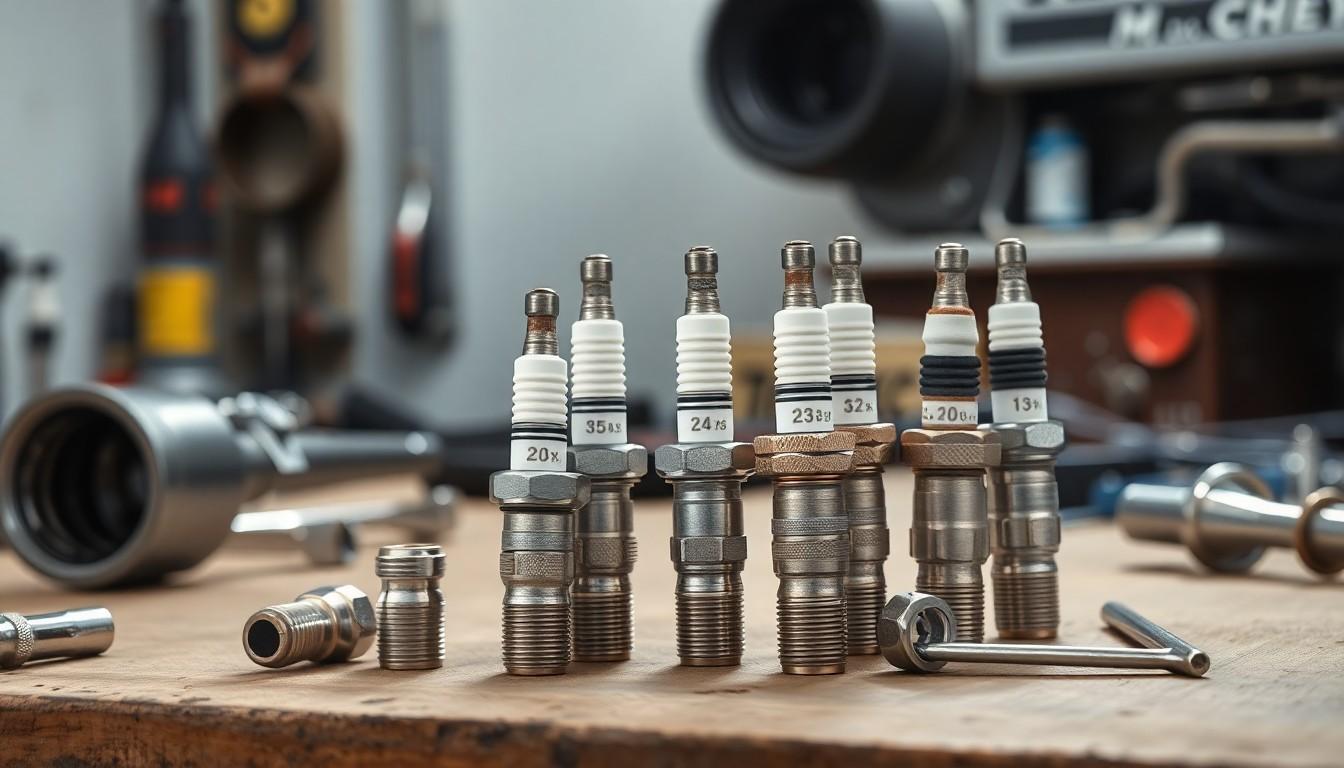Wondering when it’s time to replace those spark plugs in your vehicle? You’re not alone. This small but mighty component plays a crucial role in your engine’s performance, yet many drivers aren’t sure about the right replacement intervals.
We’ll cut through the confusion and give you straightforward guidance on spark plug replacement timing. Whether you’re driving a new car with iridium plugs or maintaining an older model with copper ones, understanding the right replacement schedule can save you money and prevent unexpected breakdowns. Plus, we’ll share the telltale signs that your spark plugs are crying out for attention before they cause bigger problems.
Understanding Spark Plugs and Their Function
Spark plugs are small but critical components in your vehicle’s engine that create the electric spark needed to ignite the air-fuel mixture in combustion chambers. These essential parts directly impact your engine’s performance, fuel efficiency, and overall reliability through their seemingly simple but sophisticated operation.
How Spark Plugs Work in Your Engine
Spark plugs operate by converting high voltage electrical energy from the ignition system into a spark that jumps across a small gap between electrodes. This well-timed spark ignites the compressed air-fuel mixture inside each cylinder, creating controlled explosions that power your vehicle forward. Each spark plug consists of a center electrode, insulator, shell, and ground electrode – all precisely designed to withstand extreme temperatures ranging from 1,000°F to 2,000°F and pressures up to 2,000 PSI during normal operation. Modern vehicles typically have one spark plug per cylinder, meaning a 4-cylinder engine contains 4 spark plugs, while an 8-cylinder engine houses 8 spark plugs.
Signs of Failing Spark Plugs
Recognizing failing spark plugs early helps prevent more serious engine complications and expensive repairs. Reduced fuel economy often serves as the first indicator, with drivers noticing they’re refueling more frequently than before. Engine misfires manifest as hesitation, stumbling, or momentary power loss when accelerating. Rough idling creates noticeable vibrations when your vehicle is stationary with the engine running. Difficulty starting the engine, particularly in cold weather, suggests spark plugs may no longer produce sufficient spark. Poor acceleration performance compared to what you’re accustomed to indicates degrading plug efficiency. Engine surging or hesitating during steady driving points to inconsistent spark plug performance. Check engine lights commonly illuminate due to misfires detected by your vehicle’s onboard diagnostic system when spark plugs fail to operate properly.
Standard Intervals for Changing Spark Plugs

Spark plug replacement intervals vary significantly based on the type of plugs installed and your vehicle’s specifications. Different materials offer varying levels of durability and performance, directly affecting how frequently they need replacement.
Conventional Copper Spark Plugs (30,000-50,000 Miles)
Copper spark plugs require more frequent replacement than other varieties, typically every 30,000 to 50,000 miles. Many manufacturer maintenance schedules, such as those for the 1st Gen CRV, recommend even shorter intervals of 24,000 miles or 24 months. These plugs use copper core electrodes that wear down faster due to the metal’s softer composition. Regular inspection helps ensure optimal performance since copper plugs deteriorate more quickly under normal driving conditions.
Long-Life Platinum and Iridium Spark Plugs (60,000-120,000 Miles)
Platinum and iridium spark plugs offer extended service life compared to conventional copper options. These premium plugs commonly last between 60,000 to 120,000 miles depending on the exact design and vehicle application. Toyota vehicles equipped with these plugs often follow an 80,000-mile replacement schedule according to manufacturer recommendations. Many high-quality iridium plugs can reach 100,000 miles before requiring replacement, with some lasting up to approximately 80,000 miles (130,000 kilometers). Operating conditions impact longevity significantly, as extreme temperatures and frequent idling can accelerate wear and necessitate earlier replacement even though the plugs’ enhanced durability.
Factors Affecting Spark Plug Lifespan

The lifespan of spark plugs isn’t uniform across all vehicles and driving scenarios. Several key factors influence how long your spark plugs will last before requiring replacement.
Driving Conditions and Habits
Environmental conditions and driving patterns significantly impact spark plug durability. Extreme temperatures, frequent idling, and stop-and-go traffic create additional stress on spark plugs, causing them to deteriorate faster than under normal driving circumstances. Aggressive driving behaviors like rapid acceleration can also shorten spark plug life expectancy. Short trips prevent the engine from reaching optimal operating temperature, which may lead to carbon buildup on the plugs and reduced efficiency over time.
Fuel Quality and Engine Condition
Fuel composition directly affects how spark plugs perform and how long they last. Low-quality fuel often contains impurities that leave deposits on spark plugs, diminishing their effectiveness and accelerating wear. Engine maintenance status plays an equally important role in spark plug longevity. Properly maintained engines with correct air-fuel mixtures create ideal combustion conditions that extend spark plug life. Regular oil changes and air filter replacements help maintain clean combustion environments that preserve spark plug functionality.
Vehicle Make and Model Specifications
Different manufacturers establish varied replacement intervals based on engine design and performance requirements. Some vehicles require spark plug replacement every 24 months or 24,000 miles, particularly those utilizing copper spark plugs. Toyota typically recommends changing spark plugs around 80,000 miles during scheduled maintenance services. Consulting your vehicle’s owner manual provides the most accurate guidance for your exact make and model. Premium vehicles often use advanced spark plug technologies that may have different service intervals compared to standard models.
Reading Your Vehicle’s Manual for Spark Plug Maintenance

Your vehicle’s owner manual contains essential information about spark plug maintenance exact to your car’s make and model. Understanding these guidelines ensures optimal engine performance and prevents unnecessary replacements or delays in maintenance.
Manufacturer Recommendations vs. Real-Industry Needs
Manufacturer recommendations typically specify spark plug replacement intervals ranging from 30,000 to 100,000 miles depending on your vehicle. Toyota, for example, recommends changing spark plugs around 80,000 miles as part of their regular maintenance schedule. These intervals aren’t arbitrary—they’re based on extensive testing under various conditions to determine optimal replacement timing for your exact engine design.
Real-industry driving conditions often impact spark plug longevity differently than controlled testing environments. Spark plugs subjected to extreme temperatures, extended idling periods, or other harsh operating conditions frequently require earlier replacement than the manual suggests. High-quality spark plugs can last up to 130,000 kilometers (approximately 80,000 miles) under ideal conditions, but this lifespan varies considerably based on actual usage patterns.
Many vehicles with copper spark plugs require replacement every 24 months or 24,000 miles, while those equipped with extended-range plugs might function properly for up to 100,000 miles. Consulting your manual provides these exact intervals customized to your engine’s design and expected performance parameters.
Warning signs such as decreased engine performance, misfires, or reduced fuel efficiency indicate potential spark plug issues even before reaching the recommended replacement interval. The manual often includes troubleshooting sections that help identify these symptoms and connect them to potential spark plug problems.
DIY vs. Professional Spark Plug Replacement

Replacing spark plugs is a maintenance task that can be tackled either as a DIY project or left to professional mechanics. The decision between these two options depends on your mechanical knowledge, available tools, and the complexity of your vehicle’s engine design.
DIY Replacement
DIY spark plug replacement offers a cost-effective solution for those with basic mechanical skills. With the right tools and some patience, many car owners can successfully complete this task themselves. This approach not only saves money on labor costs but also provides an opportunity to inspect other engine components while accessing the spark plugs. Many modern vehicles allow relatively straightforward access to spark plugs, making this a manageable weekend project for automotive enthusiasts.
Professional Replacement
Professional spark plug replacement ensures the job is completed correctly, especially for complex engine designs. Mechanics have extensive experience and specialized equipment to handle the task efficiently, typically completing what might take an amateur several hours in a fraction of the time. This option is particularly valuable for newer vehicles with tightly packed engine compartments or for those who lack confidence in their mechanical abilities. Professional service also often includes diagnostic testing to verify proper spark plug function after installation.
Tools Needed for DIY Replacement
The correct tools are essential for successful DIY spark plug replacement. A spark plug socket designed specifically to grip and protect the ceramic insulator is the primary tool required for this job. Also, you’ll need a ratchet and extension to reach the plugs, which are often recessed deep in the engine. A torque wrench is crucial for tightening the new spark plugs to manufacturer specifications, preventing damage from over-tightening or performance issues from under-tightening. For some applications, a gap gauge helps verify and adjust the spark plug gap before installation, ensuring optimal performance.
When to Seek Professional Help
Professional assistance becomes necessary in several exact situations when dealing with spark plug replacement. Lack of mechanical experience presents a important reason to seek help, as mistakes during installation can lead to stripped threads or damaged components. Vehicles with complex engine designs, particularly those with transverse-mounted V6 or V8 engines, often have difficult-to-reach spark plugs that require partial disassembly of the engine compartment. Additional issues such as misfires, rough idling, or decreased fuel efficiency might indicate more complex problems beyond simple spark plug replacement. Specialized tools requirements also play a factor, as some vehicles need particular sockets or extensions that aren’t commonly found in home toolboxes.
Benefits of Timely Spark Plug Replacement

Replacing spark plugs at the manufacturer’s recommended intervals delivers important benefits for your vehicle’s performance and longevity. These small components play a crucial role in your engine’s operation and maintaining them properly leads to several advantages.
Fuel Economy Improvements
Timely spark plug replacement directly impacts your vehicle’s fuel efficiency. Worn spark plugs can decrease fuel economy as they force your engine to work harder to generate the same power. When these components fail to create optimal ignition, your vehicle consumes more fuel than necessary for regular operation. Replacing spark plugs at recommended intervals—typically between 30,000 and 100,000 miles depending on your vehicle—helps maintain peak engine efficiency and reduces unnecessary fuel consumption.
Engine Performance and Longevity
Properly functioning spark plugs ensure smooth engine operation and extend your vehicle’s lifespan. Worn-out spark plugs commonly cause engine misfires, reduced power, and decreased acceleration capability, compromising your driving experience. Regular replacement prevents these issues while maintaining consistent engine performance. Replacing spark plugs on schedule also protects other critical and expensive components like your catalytic converter from potential damage. Many vehicles require spark plug changes every 50,000 kilometers (31,000 miles), though some modern designs can last up to 130,000 kilometers (80,000 miles) before replacement becomes necessary.
Conclusion
Regular spark plug maintenance is a vital aspect of keeping your vehicle running smoothly. While copper plugs typically need replacement every 30,000-50,000 miles platinum and iridium versions can last 60,000-120,000 miles depending on your exact vehicle.
We recommend consulting your owner’s manual for the manufacturer’s exact guidelines while staying alert to warning signs like poor fuel economy engine misfires or rough idling. Whether you choose DIY replacement or professional service timely spark plug changes will reward you with better fuel efficiency smoother performance and a longer-lasting engine.
By following these guidelines we’ll help you avoid costly repairs and keep your vehicle running at its best for years to come.
Frequently Asked Questions
How often should I replace spark plugs?
Replacement intervals vary by spark plug type. Conventional copper plugs typically need replacement every 30,000-50,000 miles. Premium platinum and iridium plugs can last 60,000-120,000 miles. Always check your vehicle’s owner manual for specific recommendations, as some manufacturers suggest replacement as early as 24,000 miles while others recommend up to 100,000 miles.
What are signs that spark plugs need replacement?
Look for decreased fuel economy, engine misfires, rough idling, difficulty starting, poor acceleration, and illuminated check engine lights. These symptoms indicate your spark plugs may be failing and require attention. Addressing these signs early can prevent more serious engine problems and costly repairs down the road.
Can I replace spark plugs myself?
Yes, if you have basic mechanical skills. DIY replacement requires tools like a spark plug socket, ratchet, torque wrench, and gap gauge. This approach saves on labor costs and allows you to inspect other engine components. However, for complex engines or if you lack confidence in your abilities, professional service is recommended.
What factors affect spark plug lifespan?
Driving conditions, habits, fuel quality, and engine condition significantly impact spark plug longevity. Extreme temperatures, frequent idling, and aggressive driving accelerate wear. Low-quality fuel leaves deposits that reduce effectiveness. Different vehicle makes and models also have varying requirements based on their specific engine designs.
What are the benefits of timely spark plug replacement?
Replacing spark plugs according to schedule improves fuel efficiency, ensures smooth engine operation, and extends vehicle lifespan. Worn spark plugs decrease fuel economy and cause performance issues. Regular replacement protects critical components like the catalytic converter and helps maintain optimal engine efficiency, saving you money in the long run.
Why are spark plugs important for engine performance?
Spark plugs create the electric spark that ignites the air-fuel mixture in combustion chambers. This directly impacts engine performance, fuel efficiency, and reliability. Each plug must withstand extreme temperatures and pressures while consistently delivering the spark needed for proper combustion. Without functioning spark plugs, your engine cannot operate efficiently.
When should I seek professional help for spark plug issues?
Seek professional help if you lack experience with vehicle maintenance, have a complex engine design, or experience persistent issues like misfires or rough idling even after replacement. These symptoms may indicate more serious problems beyond simple spark plug replacement that require diagnostic expertise.

